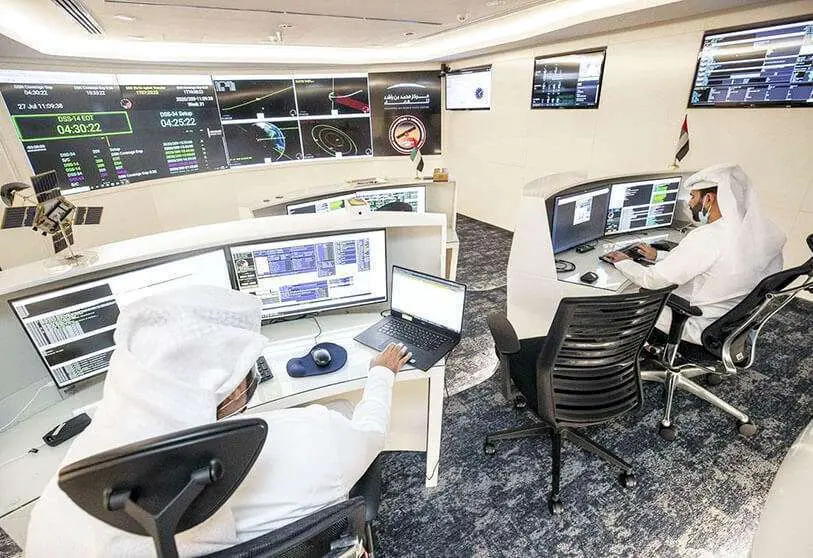Emirates' Al-Amal leads spacecraft platoon on its way to Mars

As if it were an interplanetary bicycle tour, the head of a space platoon of three spacecraft bound for Mars is already 10 million kilometres away from Earth.
All three took off in the second half of July from Japan, China and the United States and are now engaged in a frantic individual time trial whose final goal is to reach the Red Planet in February 2021, 493.6 million kilometres from our blue planet.
Leaving Earth at a speed of 12,500 kilometres per hour, the unique caravan is captained by the Emirates' Al-Amal probe, followed by China's Tianwen-1. The Mars 2020 capsule from the United States, which houses the 1-ton Perseverance all-terrain vehicle full of technology, closes the march. It includes two key Spanish systems: the high-gain antenna to communicate with the ground and the environmental and weather station, built by Airbus Space Systems, CRISA and the Astrobiology Center.
In accordance with the patterns that prevail in all interplanetary missions, the ground controllers of each of the three Martian probes have already carried out the first trajectory corrections.
In cycling this would be equivalent to a kind of refuelling in the middle of a race. In the case of this long Earth-Mars journey without propulsion -only counting on the initial impulse-, in the seven-month journey small deviations occur, which accumulate and can greatly alter the correct path.

To prevent each spacecraft from slipping from its intended point of arrival, ground-based control centres that monitor the progress of navigation in the cosmos around the clock make adjustments to trajectories to bring them back to their final destination.
This has been done by the Emirati technicians installed in the operations room of the Mohammed bin Rashid Space Center in Dubai, the Chinese at the Beijing Aerospace Control Center - some 14 kilometers from the center of the capital - and the Americans at the Space Flight Operations Center in Pasadena, California, just 20 kilometers from Hollywood.
The first to tune up the course were the Chinese, who did so on August 1st, when the Tianwen-1 probe had already covered nearly 3 million kilometres. The first of three other correction manoeuvres planned during its trip to Mars, an official statement from the Chinese National Space Administration (CNSA) - the equivalent of the United States' NASA - confirms that the spacecraft fired its thrusters for 20 seconds.

A mission that whets China's interplanetary appetites and incorporates a surface module and a small all-terrain vehicle, Tianwen-1 was launched into space July 23 from the Wenchang space base.
The Americans successfully practiced the redirection of Mars 2020 on August 14th, three weeks after its launch from Cape Canaveral. The United States National Aeronautics and Space Administration, NASA, has scheduled another five low-thrust engine firings - September 30, December 18, February 10, February 16, 2021, and hours before descent - and more if necessary, to position the Perseverance all-terrain vehicle over the great Martian crater Jezero on February 18 in search of life.
The last to alter the route were the Emirates, which executed the first of Al-Amal's seven flight correction maneuvers on August 17, nearly a month after it was launched from Japan's Tanegashima Space Center on December 19.

While China has its own very long-range communications systems, the links to reorient Al-Amal and Mars 2020 were made through the large antennas of NASA's Deep Space Network located in Europe, America and Oceania. In this way, coverage with both probes and any others is complete 24 hours a day, while the Earth rotates on itself.
The first five large antennas of the network are installed in the Californian Mojave Desert, in the Goldstone communications complex. The one in Europe is located in Robledo de Chavela, half a hundred kilometres from Madrid. Also with five impressive antennas, it is operated by Spanish technicians from the National Institute of Aerospace Technology (INTA) and the state-owned company ISDEFE.
The Australian one is located in a place about 50 kilometers from Canberra, but its four antennas are operated remotely and permanently from Robledo de Chavela. Due to the distance from the Earth they are located, which in the case of Al-Amal is 10 million kilometers and Tianwen-1 and Mars 2020 somewhat less, the delay to establish transmissions and commands to and from the site is of the order of 66 seconds, "which increases by about two seconds each day that passes and the three probes are further away," confirm Spanish telecommunications technicians.

Despite the fact that the controllers on the ground can carry out the programmed corrections on the trajectories of the three spacecrafts, the unique space platoon is not exempt from suffering from setbacks that can cause changes in its march towards Mars or even its loss.
Any of the probes may suffer a "puncture" in the form of a failure in the communications system; malfunctions in the solar panels that provide power to the equipment on board; failures in the star trackers that indicate their relative position in space; or a malfunction in their respective engines when ordered from the ground to turn on or off.
On the other hand, if the three Martian probes achieve their objectives, the Emirates will be the first Arab country to travel to another planet, China will become the third nation to place an orbiter and pose a vehicle on Mars, and the United States will reiterate its mastery and great capabilities to once again position its advanced technology on the Red Planet.









